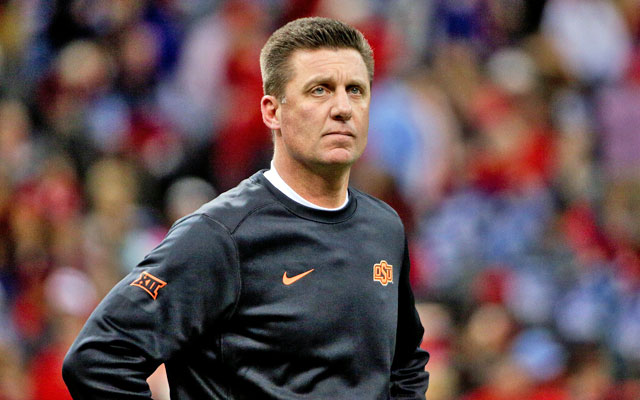STILLWATER, Okla. -- Texas should eliminate the Longhorn Network or the Big 12 faces more instability, Oklahoma State coach Mike Gundy told CBS Sports on Monday.
Gundy's said the league overall needs to market itself better. The conference, he said, is at a disadvantage because of the widespread distribution and success of the SEC Network and Big Ten Network.
Eliminating LHN -- which he called a “failure -- and creating a conference-wide Big 12 Network would give the league more national exposure, Gundy added.
“If we don’t eliminate the Longhorn Network and create our own network, they’re going to continue to have issues with this league,” Gundy said as the Cowboys returned from spring break to continue spring practice.
He continued: “You don’t have a Big 12 Network; you have a network within the league that people consider a failure.”
LHN’s struggles are well-documented. The school-centric network reportedly has lost $48 million since its launch in 2011. Its annual losses are now in the single-digit millions, according to a source. Both ESPN and Texas seem committed to the 20-year, $295 million agreement that would pay the school an average of $15 million per year.
“Everything is based on marketing,” Gundy said. “Right now the Big 12 is not getting the marketing we need because of the Longhorn Network. Now, nobody wants to hear that but …”
Gundy is also worried about other issues, such as recruiting. It’s no secret the Big 12 slipped in recruiting this year, particularly in Texas.
“You are getting the SEC Network, and you are getting the Big Ten Network and you are getting the Pac[-12 Network],” Gundy said. “Until we come together as a group [and] find a financial solution to eliminating the Longhorn Network, [there will be issues].”
Gundy’s views on the network are the same as those of Oklahoma president David Boren. Oklahoma’s former governor has been the most outspoken Big 12 source on the subject saying the league needs to expand and add a conference championship game.
“I appreciate what Boren is doing,” the coach said.
It’s been suggested there is a way to fold LHN into a possible Big 12 Network. The infrastructure is already there in Austin.
“If Texas doesn’t [fold LHN] in X number of years, they’re going to be in the Pac-12 or SEC,” Gundy said. “If that’s what they want, keep riding this horse. If you don’t want that, you better make some changes or it’s going to happen whether you like it or not.”

The league is in the process of a wide-ranging discussion on those subjects. If it does any or all of the three -- expansion, network, league championship game -- it will likely be announced by this summer.
“I don’t see anyone coming into this league,” Gundy said. “Who you going to get? You need strong football history, tradition, some type of television market. They want schools that have reputation academically. That market is not out there right now.”
A conference championship game could be a coin-flip decision for the Big 12. Does it want to get back into a postseason format where the underdog has won 28 percent of the time since league champ games started in 1992?
In the 15 years the Big 12 staged such a game (1996-2010), the underdog covered or won outright 40 percent of the time. If the Big 12 held a league championship game in 2015, Oklahoma and Oklahoma State would have played consecutive contests.
“We don’t need a championship game,” Gundy said matter-of-factly.
Much of the programming for a conference network would have to come from so-called third-tier inventory -- minor sports below football and basketball. Big 12 schools currently distribute those sports on a variety of platforms ranging from digital to regional sports networks.
The Big 12 still has nine years to run (through 2024-25) on its current rights deal with ESPN and Fox. The league is bonded together by that deal and a grant of rights. That means if a school leaves at any time before the term of that contract its television rights stay with the Big 12.
Essentially, no schools can leave without a massive legal fight. Some blamed the unique one-school nature of LHN for the Big 12’s upheaval at the beginning of this decade. The league shrunk to eight teams before quickly adding West Virginia and TCU. Its rights fees put it third among all conferences, behind the SEC and Big Ten.
The Big 12 distributes between $23-25 million per year to member schools. Bowlsby told CBS Sports if the conference does nothing to address the current disparity, it will be $20 million per school annually behind the SEC and Big Ten in 12 years.
Gundy’s comments on the subject are the first from a Big 12 coach. He knows a league coach doesn’t have much say in such matters but spoke out anyway during a wide-ranging discussion regarding football.
Gundy, 48, is third in seniority in Big 12 experience among the league’s current coaches going into his 12th season.
“It’s not working right now, in my opinion,” Gundy said. “It’s nobody’s fault. It’s not the Longhorn Network and it’s not Texas. But who’s going to give in, who is going to make it work?”
The 4 1/2-year old LHN currently has about 20 million cable TV subscribers nationwide. The subscription fee -- what viewers pay on their monthly cable bill -- in the Texas footprint is approximately 28 cents for its 6.5 million viewers.
That fee is significantly lower outside of Texas.
“We can't do a network without Texas raising its hand and saying, ‘We're willing to roll it in,'" Bowlsby told CBS Sports in early March. “We've had those conversations, but they haven't raised their hand. But they also haven't said, ‘Stop right now. We're not willing to talk about it.'”
Bowlsby had no comment Monday on Gundy’s views.















